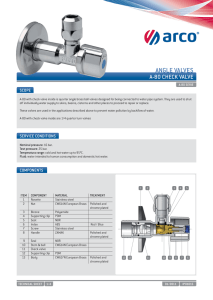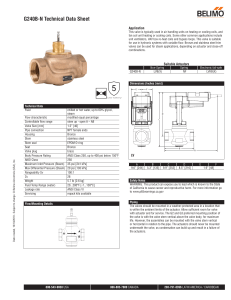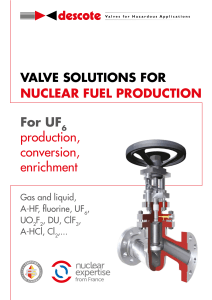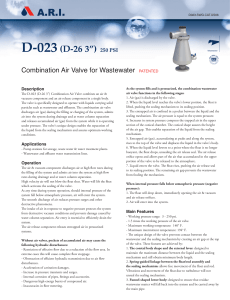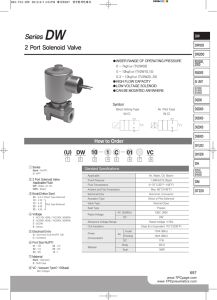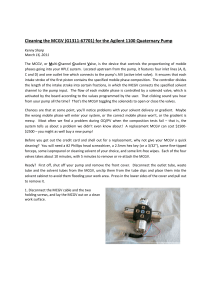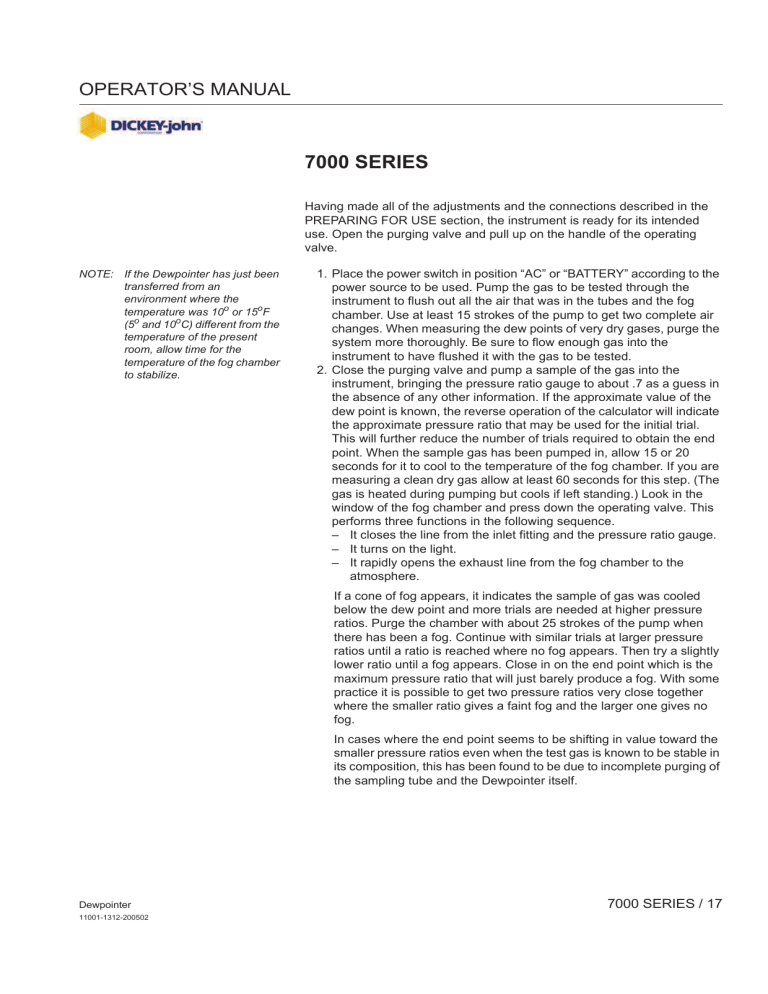
OPERATOR’S MANUAL 7000 SERIES Having made all of the adjustments and the connections described in the PREPARING FOR USE section, the instrument is ready for its intended use. Open the purging valve and pull up on the handle of the operating valve. NOTE: If the Dewpointer has just been transferred from an environment where the temperature was 10o or 15oF (5o and 10oC) different from the temperature of the present room, allow time for the temperature of the fog chamber to stabilize. 1. Place the power switch in position “AC” or “BATTERY” according to the power source to be used. Pump the gas to be tested through the instrument to flush out all the air that was in the tubes and the fog chamber. Use at least 15 strokes of the pump to get two complete air changes. When measuring the dew points of very dry gases, purge the system more thoroughly. Be sure to flow enough gas into the instrument to have flushed it with the gas to be tested. 2. Close the purging valve and pump a sample of the gas into the instrument, bringing the pressure ratio gauge to about .7 as a guess in the absence of any other information. If the approximate value of the dew point is known, the reverse operation of the calculator will indicate the approximate pressure ratio that may be used for the initial trial. This will further reduce the number of trials required to obtain the end point. When the sample gas has been pumped in, allow 15 or 20 seconds for it to cool to the temperature of the fog chamber. If you are measuring a clean dry gas allow at least 60 seconds for this step. (The gas is heated during pumping but cools if left standing.) Look in the window of the fog chamber and press down the operating valve. This performs three functions in the following sequence. – It closes the line from the inlet fitting and the pressure ratio gauge. – It turns on the light. – It rapidly opens the exhaust line from the fog chamber to the atmosphere. If a cone of fog appears, it indicates the sample of gas was cooled below the dew point and more trials are needed at higher pressure ratios. Purge the chamber with about 25 strokes of the pump when there has been a fog. Continue with similar trials at larger pressure ratios until a ratio is reached where no fog appears. Then try a slightly lower ratio until a fog appears. Close in on the end point which is the maximum pressure ratio that will just barely produce a fog. With some practice it is possible to get two pressure ratios very close together where the smaller ratio gives a faint fog and the larger one gives no fog. In cases where the end point seems to be shifting in value toward the smaller pressure ratios even when the test gas is known to be stable in its composition, this has been found to be due to incomplete purging of the sampling tube and the Dewpointer itself. Dewpointer 11001-1312-200502 7000 SERIES / 17 OPERATOR’S MANUAL Figure 5 Type 7000 3. When making the last trial near the end point, wait at least 60 seconds for the sample of gas to cool after it has been pumped up to the desired pressure ratio. Then press down on the handle of the operating valve. With some experience, an operator will find that he can determine the end point very easily if he begins with pressure ratios that are too small and uses the density of the fog on any trial as a guide to the selection of his next trial pressure ratio. When two critical pressures as described above are determined, take the numerical average and call that the true end point. 4. Having determined the end point, read the temperature on the thermometer and look up the Q value of the gas being tested. With these numbers, use the Dewpointer Calculator to compute the dew point temperature as described in the CALCULATOR section. Experience has shown that about three independent determinations should be made just to prove that the system has been properly purged and that the dew point temperature is not drifting downward due to the further drying of the connecting hose or tubing and the inside of the Dewpointer. 5. When measuring the dew point of very dry, clean gas such as compressed, bottled gas, allow at least 60 seconds for the ions to form in the gas compressed into the fog chamber before pressing on the operating valve. When very little moisture is within the gas and very little radioactive material is inside the fog chamber, it takes time for the generation of enough ions to fill the chamber and thereby permit the 18 / 7000 SERIES Dewpointer 11001-1312-200502 OPERATOR’S MANUAL formation of a visible fog. With a deficiency of ions, it may not be possible to get a visible fog even at the correct pressure ratio. The operator would logically compress the gas more in order to get a fog and determine the end point. This would result in the determination of a dew point that is much too low. The gas was cooled too much because the proper fog was not seen at the end of 15 or 20 seconds. The waiting time after compression may have to be extended to two or three minutes. These very thorough measures should be taken in determining the true end point after the simpler steps have shown the approximate end point. Only when measuring negative dew point temperatures is it necessary to allow the extra time for ionization of the compressed gas in the fog chamber. Never depress the gauge valve unless the operating valve is out and the purging valve opened and the supply line valve closed. CONCERNING THE TYPE 7280 OXYGEN DEWPOINTER This type of Dewpointer is mechanically like the Type 7000 Dewpointer and the operation is just as described for the Type 7000. The Type 7280, however, is safe to use with oxygen because it has special lubrication, special O-rings, and special gaskets and other sealing components. Oxygen is a very active gas that can combine with many substances such as oils, greases and fuel gases so very rapidly as to be explosive. Therefore, Dibutyl Phthalate, which does not readily oxidize, is used in the pressure ratio gauge. The special parts for the Oxygen Dewpointers are shown at the end of the MAINTENANCE AND SERVICE section. When ordering spare parts, be sure to use the correct numbers for the Oxygen Dewpointer parts. A mistake at this point could have very serious consequences. Dewpointer 11001-1312-200502 7000 SERIES / 19 OPERATOR’S MANUAL 20 / 7000 SERIES Dewpointer 11001-1312-200502 OPERATOR’S MANUAL 7200 SERIES Type 7200 Dewpointers are intended for those applications where the gas to be tested is supplied under pressure with 50 psig (345 kPa) being adequate for nearly all situations. Three factors determine the minimum useful pressure of the gas being supplier; 1. The minimum dew point to be determined. 2. The Q value of the gas under pressure. 3. The current barometric pressure. Assuming a local barometric pressure of 29.92 inches of mercury (760 mm Hg) and a fog chamber temperature of 75oF (24oC), minimum supply pressures in psig and kPa are shown in Figure 4. Actual pressures built up in the fog chamber must be controlled by a good needle valve placed in the supply line between the Dewpointer and the source. This valve will limit the flow into the fog chamber and permit the operator to set the pressure ratio gauge to the selected value. Do not use a pressure regulator because it holds moisture. The rear outlet fitting of the Dewpointer may be connected to a suitable waste line that will not build up any back pressure. ADJUSTMENTS Very carefully make the Unity Adjustment on the pressure ration gauge. Failure to follow these steps in proper order may cause the manometer fluid to be blown out the top of the gauge. 1. 2. 3. 4. Close the supply line flow-control needle valve. Place the operating valve in the out position. Open the purging valve. Press the gauge valve. While this valve is depressed turn the adjuster until the bottom of the meniscus of the fluid column is on the 1.0 mark. 5. Release the gauge valve. Never depress the gauge valve unless the operating valve is out and the purging valve opened and the supply line valve closed. The Unity Adjustment should be checked frequently – particularly if the instrument temperature or barometric pressure is fluctuating. Dewpointer 11001-1312-200502 7200 SERIES / 21 OPERATOR’S MANUAL Figure 6 Type 7200 OPERATIONS Open the purging valve. Pull up on the operating valve handle. Turn the switch to the A-C or BATTERY position according to the power source that is to be used. Flow the test gas through the instrument tubing and fog chamber to purge them. Open the inlet valve and adjust the flow rate so that the pressure ratio gauge indication is about “.8”. Permit the gas to flow through the instrument at this rate for a couple of minutes. This will flush out the atmospheric air in the instrument. This purging operation is required whenever the instrument has not been used for several hours. No further adjustments of the flow-control valve will be required. All further operations will be on the panel of the instrument. Close the purging valve and permit the pressure ratio indication to climb to approximately mid-scale. Close the inlet valve. 22 / 7200 SERIES Dewpointer 11001-1312-200502 OPERATOR’S MANUAL The Alnor Dewpointer Type 7200 is equipped with an automatic pressure relief valve that operates at approximately 60 psi (415 kPa) in the case of the 7200-U. If the pressure in the instrument exceeds this value the relief valve will open and by-pass the gas directly to the outlet. This makes possible the use of a needle valve (instead of pressure regulator) at the source of a high pressure gas. If the pressure of the gas source exceeds the pressure at which the relief valve opens it is natural for gas to be flowing from the discharge of the instrument whenever the inlet valve is closed. The instrument is also equipped with a pressure rupture disc which will rupture at approximately 200 psig (1380 kPa), thus completely protecting the instrument against over-pressure hazards. Look into the observation window and depress the operating valve; observe whether a fog (cone of sunbeams) appears. Depressing the operating valve performs three operations in the following sequence: 1. Closes the line between the fog chamber and the pressure ratio gauge. 2. Turns on the light. 3. Opens the line from the fog chamber to the atmosphere. If a fog forms, it indicates that the sample was cooled below the dew point, and the next trial should be made at a greater pressure ratio (lower pressure). If a fog does not form, it indicates that the sample was not cooled to the dew point and the next trial should be at a lesser pressure ratio (higher pressure). Open the purging valve; pull out the operating valve; open the inlet valve. Maintain the flow for five or ten seconds to flush out the old sample. Make additional trials until you have located one pressure ratio at which a fog appears and one at which no fog appears. Now “close in” on the “end point” – the point at which a fog can barely be produced. You should be able to narrow the difference between the appearance and the non-appearance of the fog to only one minor division apart on the gauge. The experienced operator will find he can determine the end point after a few trials since the density of the fog on any given trial is a valuable clue to how far he is from the end point. If the approximate value of the dew point is known, the reverse operation of the Dew Point Calculator will indicate the approximate pressure ratio which should be used for the initial trial. This will further reduce the number of trials required to achieve the end point. Be sure to repeat the five to ten second purging operation between trials. Dewpointer 11001-1312-200502 7200 SERIES / 23 OPERATOR’S MANUAL For calculation purposes, take the average between the minimum pressure ratio that fails to produce a fog and the maximum pressure ratio that produces a fog. Use this value with the initial temperature as read on the thermometer and the Q value for the gas being tested to compute the dew point with the Alnor Dew Point Calculator. Refer to the CALCULATOR section on how to use the Calculator. When measuring dew point temperatures in the negative region, be sure to allow time for the radioactive material to ionize a large amount of gas in the fog chamber; let the gas remain in the chamber to become ionized for at least two minutes before pressing down on the operating valve. When the dew point is minus 20oF (-30oC) and below, the fog becomes thin and wispy; it swirls around in the center of the chamber and fades rapidly. 24 / 7200 SERIES Dewpointer 11001-1312-200502 OPERATOR’S MANUAL 7300 SERIES In the 7300 Series Dewpointer, there are three different types that deserve special mention. The 7350 Dewpointer is much like the Type 7200 described previously in that it requires that the source of the gas to be tested to be pressurized up to perhaps 55 psi (380 kPa). The instrument for measuring the temperature of the fog chamber is an electric resistance thermometer instead of the glass thermometer used in the 7000 or the 7200 series of instruments. The 7300-D Dewpointer is like the 7300 instrument except that it has removable scales that are placed behind the pressure ratio gauge to provide the desired range of measurement without the need to use the Dewpointer Calculator. These scale cards are shown in Figure 9 - one card carries the familiar pressure ratio scale. The Type 7300 Dewpointer has a range like the 7000-U but it has the electric resistance thermometer to measure the temperature of the fog chamber. It also has a fine-wire thermopile inside the chamber to show when the gas has cooled to the same temperature as the walls of the fog chamber. Follow the instructions in the PREPARING FOR USE section. When the preparations and connections are completed, open the purging valve and pull up on the handle of the operating valve. If the instrument has just been transferred from another room where the temperature was 10 or 15 degrees different from the temperature of the present room (5-10oC), allow time for the temperature of the fog chamber to stabilize as shown by the resistance thermometer. 1. Place the power switch in position A-C or BATTERY according to the power source to be used. Pump the gas to be tested through the instrument to flush out the air that was in the tubes and the fog chamber, using at least 15 strokes of the pump to get two air changes. When measuring the dew point of very dry gases, purge the system more thoroughly. Be sure to flow enough gas through the system to have it flushed and filled with the gas you want to test. 2. Close the purging valve and pump a sample of the gas into the instrument, bringing the pressure ratio gauge up to the .7 mark in the absence of any other information about the probable dew point. Turn the selector switch on the temperature indicator to “GALV” and watch the pointer return to its “Z” point. This shows when the gas has reached the temperature of the wall of the chamber. If clean dry gas is being measured wait at least an additional 45 seconds before proceeding. Move the selector switch to “TEST”, press the push button and watch the pointer move to the “T” point on the scale. If necessary, turn the “T-ADJUSTER” knob to center the pointer on the “T” point. Move the selector switch to “TEMP” and read on the meter the temperature of the fog chamber. Look in the window of the fog chamber and press down the handle of the operating valve. Dewpointer 11001-1312-200502 7300 SERIES / 25 OPERATOR’S MANUAL Figure 7 Type 7300 3. If a cone of fog appears, it indicates that the gas was cooled below the dew point and more trials are needed at higher pressure ratios. Purge the system with about 25 strokes of the pump when a fog has appeared. Continue with similar trials at higher pressure ratios until a ratio is reached where no fog is seen. Then try a slightly lower ratio until a fog appears. Close in on the end point which is the largest pressure ratio that will just barely allow a fog. With some practice, it is possible to get two ratios very close together where the smaller ratio gives a fog and the higher ratio gives no fog. Take the average of these two ratios and use that as a measure of the true end point. This can be used with the dew point calculator to determine the dew point temperature. 4. When making the last trials near the end point, be sure to wait until the gas has reached the temperature of the walls of the fog chamber before pressing the operating valve. An operator may find that he can arrive at the end point more easily if he begins with pressure ratios that are too small and uses the density of the fog on any given trial as a guide to the next pressure ratio he should try. 5. When measuring very low dew points and getting close to the end point, allow long times to elapse after the gas is compressed into the fog chamber so that the gas can get thoroughly ionized. When only a very small amount of water vapor is in the sample of gas, many ions are required to provide a visible fog. At -50oF (-45oC), the time of 26 / 7300 SERIES Dewpointer 11001-1312-200502 OPERATOR’S MANUAL waiting for the establishment of equilibrium conditions has been 3 minutes. PREPARING AND USING THE TYPE 7350 DEWPOINTER This instrument contains no pump and therefore it requires that the gas to be tested be supplied from a pressurized source. Refer to the 7200 AND 7350 SERIES section and follow the steps for connections and adjustments. The following must be added to the adjustments for the meter: 1. Turn the selector switch on the meter to “GALV”. 2. The pointer of the meter should rest at the “Z” point. If necessary, correct it by turning the small screw just above the switch handle. 3. Set the power switch to “BATTERY”. Turn the selector switch to “TEST” and press the pushbutton. 4. The pointer should move to the “T” point. If necessary, turn the “T-ADJUSTER” to center the pointer at “T”. 5. Turn the switch to “TEMP” and read the temperature of the fog chamber. OPERATIONS Open the purging valve and press down on the handle of the operating valve. This will allow the purging air to flow through the fog chamber and thus clear it out. Flow the test gas through the instrument to purge it, allowing the gas to flow for two or three minutes especially when the dew point is expected to be in the negative region. Continue with the second paragraph under “Operations” in the 7200 AND 7350 SERIES section. It will be noticed that the various manipulations of the Type 7350 are a combination of these for the Type 7200 and the Type 7300. At -20oF (-30oC), a recommended waiting time for the generation of an adequate number of ions is at least 1 ! minutes. This addition to the technique of measuring low dew points has been found to provide more reliable measurements. It eliminates the need for super-cooling the gas in order to obtain a fog. The number of degrees of super-cooling appears as an error in the measurement. When an end point has been established, use this ratio, the Q value for the gas, and the initial temperature of the fog chamber to compute the dew point on the Calculator as described in the CALCULATOR section of this manual. Dewpointer 11001-1312-200502 7300 SERIES / 27 OPERATOR’S MANUAL PREPARING AND USING THE 7300-D DEWPOINTER The 7300-D Dewpointer resembles the 7300 instrument in all respects except that its manometer block is hollowed out behind the liquid column to accept the detachable scales. There are two special knurled screws to hold each scale in place. One of the scales is marked in units of pressure ratio and when it is installed, the 7300-D is used in exactly the same manner as the 7300. The other three scales are marked directly in temperature, either o F or oC, as ordered. The Fahrenheit scales are shown in Figure 9; Celsius scales are similar. Select the proper scale by referring to Figure 8 and considering both the starting temperature and the probable dew point. Figure 8 Scale Determination Table 28 / 7300 SERIES Use Scale No. For Ambient Temperatures Range of the Dew Point Temperatures 1 50 to 120 F 10 to 50 C -60 F to 10 below ambient -50 C to 5 below ambient 2 90 to 120 F 30 to 50 C -10 F to 10 below ambient -25 C to 5 below ambient 3 60 to 90 F 15 to 30 C -30 F to 10 below ambient -35 C to 5 below ambient 4 30 to 60 F 0 to 15 C -50 F to 10 below ambient -50 C to 5 below ambient Dewpointer 11001-1312-200502 OPERATOR’S MANUAL Figure 9 Scale Cards for Type 7300-D -30 0 .45 -30 0 30 -20 .7 50 60 F F 70 .75 20 30 40 Dewpoint .65 40 Dewpoint .6 F 10 Dewpoint Ratio Pressure -40 -10 20 .55 -50 -20 10 .5 alnor Q-285 -10 Q-285 .4 alnor alnor Q-285 alnor .8 1 110 120 Scale 3 .95 100 Scale 2 Scale 1 .9 10 60 30 70 40 80 90 Scale 4 90 .85 0 20 50 80 -10 50 60 Install the chosen scale and tighten the two screws by fingers only. Follow the steps given for the 7300 regarding the connections and adjustments. Measure the temperature of the fog chamber with the electric thermometer and set the controls as follows: 1. 2. 3. 4. Open the purging valve. Raise the handle of the operating valve. Depress the gauge valve. Turn the Unity Adjuster knob to bring the fluid column to the measured fog chamber temperature. 5. Release the gauge valve. Remember that the direct reading scales are accurate only for the gases having Q value of .285 as listed in Figure 3. Leave the meter switch in the “GALV” position when it is not being used for the other two functions. It will let the meter indicate small temperature differences between the gas and the fog chamber. Put the toggle switch in the A-C position if power is available from the line. Open the purging valve; pull out on the operating valve; and adjust the flow control valve, if present, to cause the gauge liquid to rise no more than one division on its scale. Dewpointer 11001-1312-200502 7300 SERIES / 29 OPERATOR’S MANUAL Pump the gas through the Dewpointer to purge it for about 5 minutes if it has had moist air in it and the expected dew point is -30oF (-35oC) or below. Purging is very important at the low dew points (Scale #2 and #3) because moisture given off by the tubing may cause errors until the tubing is dried. Close the purging valve and pump a sample into the fog chamber, increasing the pressure until the fluid column rises to the anticipated dew point temperature. Wait at least 15 or 20 second for the gas to cool after it has been pumped up; with clean dry gasses at least 60 second is required. Look into the observation window and push down on the operating valve. If a fog appears it indicates that the gas has cooled below its dew point and it should be tested again with lower pressures – a shorter gauge column. If no fog appears, the gas did not cool down to its dew point, so it will have to be tested again starting with a higher pressure – longer gauge column. It will be observed that the higher pressures (longer gauge column) coincide with lower dew point temperatures on all three temperature scales. Open the purging valve; pull out on the operating valve; for about one minute operate the pump to purge the chamber. It may have been noticed that when gas is pumped into the fog chamber the meter pointer moves upscale briefly and when the valve is pressed down the meter deflects downscale. These deflections show qualitatively the temperature changes in the gas due to compression and expansion. They also tell when the gas has returned to the fog chamber temperature. The goal in using the 7300-D Dewpointer is to determine the pressure in the manometer that will produce a barely visible fog in the cone of light. This pressure is the end point that is read as Degrees Fahrenheit on Scales #2, #3, and #4. Having found a pressure that will produce a very slight fog and a little different pressure that produces no fog, it is usually possible to get these two points to e about one division apart on the temperature scale. When checking for the final end point, there are some details which deserve special attention: 1. Check the “Z” and “T” adjustments on the meter. 2. Measure the fog chamber temperature and using the Unity Adjuster, set the manometer column to indicate this same temperature. 3. Thoroughly purge the Dewpointer with the sample gas. 4. After pumping the sample into the fog chamber, let the gas stand in the chamber for awhile to become ionized by the radioactive material. When working near the lowest temperature on the three scales, wait one minute for Scale #2; two minutes for Scale #3; and three minutes for Scale #4. At the end of the waiting time, press down on the operating valve and observe the fog. This procedure will minimize errors when measuring very low dew points. 30 / 7300 SERIES Dewpointer 11001-1312-200502 OPERATOR’S MANUAL REPAIRING AND SERVICE Because of the Radium 226 or Americium 241 inside the fog chamber of many Dewpointers, a person who has not been trained and licensed to work with Dewpointers containing either Ra-226 or Am-241 must not open the fog chambers containing radioactive foil. Ship the Dewpointer to DICKEY-john Corporation. Do not open the fog chamber and NEVER allow a finger (or any part of your body) to come in contact with the foil. For shipping instructions, please refer to the SHIPPING section. If there is no small rectangular foil fastened on the left-hand wall of the fog chamber, then it contains no Radium 226 or Americium 241 and the instrument can be completely serviced in the field. SPECIAL NOTE FOR DEWPOINTERS CONTAINING AM-241 - If your Dewpointer contains Americium 241 (look for Am-241 on the radiation label on the instrument case) it is subject to Nuclear Regulatory Agency requirements that it be tested for leaks every 3 months. Refer to the PREFACE and the LEAK TESTING section for additional information. Cleanliness is most important for a Dewpointer; keep your Dewpointer clean and well lubricated. Follow these specific steps: 1. Filter – Check the fiber glass filter material frequently and replace it as soon as it begins to darken. The dirt on the glass fibers holds moisture and will make it difficult to get a reproducible measurement of a low dew point temperature. Be sure the screen and disk are in place at the bottom of the filter barrel. If an external filter is being used, Figure 24, make sure all joints are tight and that the glass wool is clear white. 2. Bubbles in the Pressure Ratio Gauge – It is normal for bubbles to appear in the fluid column of the pressure ratio gauge after the Dewpointer has been transported or has been used to measure hydrogen gas. In the 7000 and 7300 Series of Dewpointers these bubbles can be freed by pumping up the column and then releasing the pressure with purging valve. It is helpful to turn the Unity Adjuster fully in and to tip the instrument about 45 degrees to the left while working the pump. Have the operating valve handle out and purging valve closed. Tipping the instrument case to the left while working the pump will release the bubbles. Dewpointer 11001-1312-200502 REPAIRING AND SERVICE / 31 OPERATOR’S MANUAL Type 7200 and 7350 have no pump but pressure from the source of compressed gas can be used to raise the column of manometer fluid which can then be released by opening the purging valve. While pressurizing the instrument, keep the purging valve closed and carefully regulate the pressure with the inlet valve. Keep the case tilted to the left as pressure is admitted and advance the Unity Adjuster as gas is displaced from the fluid. 3. Replacing Lost Manometer Fluid – When fluid is accidentally blown out through the manometer valve, this valve must be removed and cleaned as in paragraph 7 on the following page. NOTE: Do not use the standard fluid when refilling a Dewpointer used for oxygen service. Oxygen Dewpointers – use AL556-044-032 fluid ONLY. All other Dewpointers – use AL556-044-018 manometer oil. New fluid must be added as follows: a.Have the purging valve open and operating valve up. b.Remove the knurled cap of the OIL REFILL and take out the needle screw. c.Set the Unity Adjuster to its mid-position. d.Tilt the instrument case to the left. e.Depress the gauge valve and hold it while adding fluid to the filling well from the dropper spout on the plastic fluid bottle. Release the gauge valve before removing the spout from the well. Add fluid to bring the column up to the 1.0 mark of the manometer scale. Tighten the needle screw in place before attempting to operate the Dewpointer. 4. Leaks – To operate correctly, the Dewpointer must be free of leaks in its tubes, valves, and fittings. Pump the fluid column up near its top and close all valves. The height should remain fixed except for temperature changes. If the column drifts downward, try to observe the rate of drift. Press down on the operating valve and again observe the rate of drift. a. If the fluid appears stable, the leak is in the fog chamber or the piping to it. Inspect the gaskets at the window and the lens. Tighten the caps by hand to compress their soft gaskets. b. If the leak persists and seems a little faster with the operating valve pressed down, the leak is in the operating valve itself, the pump discharge valve or the tubing connections to the reservoir. The purging valve can be reseated by tightening the needle screw into the seat. Looseness in the packing of the operating valve can be taken up by tightening the top cap. The piping joints can be tested with a soap solution or “Leak-Tec” or “Seamtest Concentrate” solution. c. When installing new filter material, be sure no glass fibers remain outside the chamber or under the gasket. A leak will contaminate the air sample. The steps listed above are correct for Dewpointers in which there is a pump. The next steps are the Types 7200 and 7350. d. There is a safety fuse or rupture disk under the panel behind the inlet fitting. The gasket within this must be in good condition; the disk must be unbroken; and the cap must be tight. 32 / REPAIRING AND SERVICE Dewpointer 11001-1312-200502 OPERATOR’S MANUAL e. There is a safety relief valve behind the panel in the inlet line. This contains an O-ring seat and a brass plunger that is held against the seat with a spring. A flaw in any one of these components could cause a leak. See Figure 5 for details of this assembly. f. The cap of the filter should be kept tight enough to compress the gasket and insure a good seal. When installing new filter material, be sure no glass fibers remain outside the chamber or under the gasket. This would allow a slow leak. 5. Operating Valve – The operating valve generally requires little maintenance aside from occasional tightening of the top cap. If it is necessary to disassemble the valve be sure to follow Figure 15 carefully when reassembling. Lubricate all parts with petroleum jelly before reassembling. Use the silicone grease for the oxygen Dewpointers. 6. Fog Chamber – If there is Radium 226 or Americium 241 in the fog chamber, just keep the window and lens clean and keep the end caps tightened by hand only. DO NOT OPEN THE FOG CHAMBER. 7. Ratio Gauge – If the manometer fluid is accidentally blown out through the gauge valve, this valve must be removed and washed with mineral spirits to dissolve the fluid. Remove the push button assembly using an open end wrench. Use a !” spanner or two small screwdrivers to unscrew the valve assembly from the manometer block. Do not try to operate the Dewpointer when fluid is low or the valve removed; the diaphragm may be damaged. Refer to Figure 16 when replacing parts in the ratio gauge assembly. Be sure the O-ring is in place when inserting the manometer valve assembly. Tighten the valve against the O-ring just enough to prevent leaking but avoid cracking the block. Tighten the push button assembly just enough to prevent turning since it does not seal against pressure. Leaks at the Unity Adjuster can be corrected by replacing the two O-rings or the complete adjuster. See Figure 16. Because of the high coefficient of expansion of the manometer oil, frequent readjustment to the 1.0 mark is quite normal if the temperature is changing. Warning about Oxygen Dewpointers - When servicing an oxygen Dewpointer, you must use the special O-rings, lubricant, and manometer fluid listed at the end of the Parts List. Using standard parts may ruin the pressure ratio gauge. 8. Reservoir – If the diaphragm is damaged (usually stretched) the fluid column in the pressure ratio gauge will not come up to the right pressure. Excessive pumping becomes necessary and the correct dew point cannot be obtained. The diaphragm is a Mylar Film. This material is very tough and it is most improbable that rupture will occur; however, depressing the gauge valve when the instrument is under pressure may stretch the diaphragm. This may also result from pumping when the Operating plunger is depressed. If this happens the diaphragm Dewpointer 11001-1312-200502 REPAIRING AND SERVICE / 33 OPERATOR’S MANUAL must be replaced. In most of these cases, the instrument should be sent back to the manufacturer for cleaning and repair. 34 / REPAIRING AND SERVICE Dewpointer 11001-1312-200502 OPERATOR’S MANUAL LEAK TESTING If your Dewpointer contains Americium 241 it must be wipe/leak tested every three months. This wipe/leak requirement is in accordance with regulations from the Nuclear Regulatory Commission and Agreement states Licensing Agencies. A wipe/leak test kit to perform the wipe/leak test must be obtained from a firm authorized or licensed by the Nuclear Regulatory Commission or an Agreement State Agency to perform such test. When the kit is received, the Dewpointer should be wipe tested following the directions of the kit at the opening of the purging (gas outlet) valve. The wipe sample should then be returned according to the instructions supplied with the kit, to the firm which issued the kit. The results of the wipe test must be kept on file for review by the Nuclear Regulatory Agency or the Agreement State Agency. Dewpointer 11001-1312-200502 LEAK TESTING / 35


